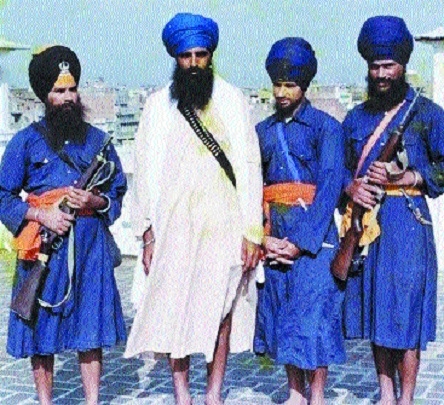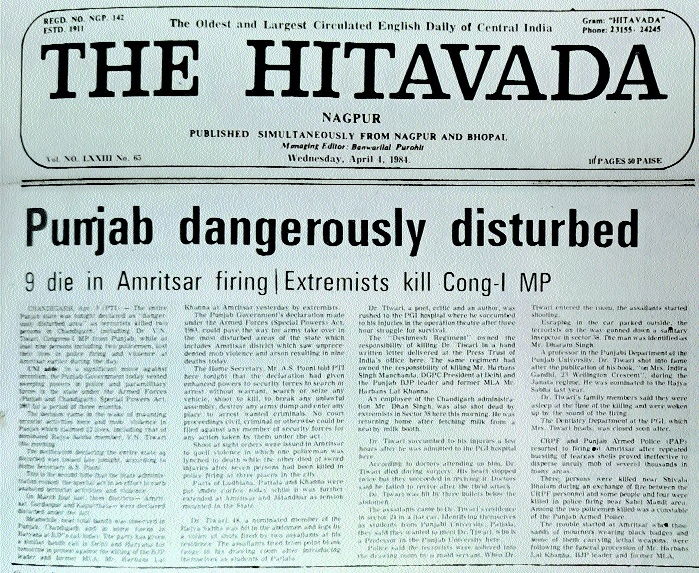Politics fuels the rise of Bhindranwale
| Date :30-Jul-2023 |

By Kartik Lokhande :
The Khalistan Files -- III
The developments abroad and propaganda with active support of Pakistan had their bearing on the situation in India too. A heady mix of religion and politics brewed in Punjab around 1980. Political considerations, centred around short-term gains and shorn of foresightedness, aided the rise of ‘Sant Bhindranwale’, pushing Punjab and Sikh community into deeper trouble.
As is known to all, and put crisply by legendary journalist B G Verghese in his autobiography ‘First Draft: Witness to the Making of Modern India’, “As by-product of the rivalry between
(Contd from page 1)
Zail Singh, the Union Home Minister, and Darbara Singh, Punjab’s Chief Minister, in the early 1980s, an obscure sant, Jarnail Singh Bhindranwale, was built up by Zail Singh and soon grew to become larger than life”.
In the words of another acclaimed journalist-author of the time Khushwant Singh, Jarnail Singh Bhindranwale was ‘an obscure, fundamentalist Sikh preacher, a school dropout’. As per an account in Khushwant Singh’s widely referred to book ‘The Sikhs’, Bhindranwale “was thrust on to center stage by the Congress Party. He had a supporter in Giani Zail Singh, a former Punjab Chief Minister and then Home Minister in Indira Gandhi’s Cabinet (He would later become the nation’s President). Zail Singh’s intention was to sow confusion in the Akali Party’s ranks. He succeeded in doing exactly that but at a huge cost. The Congress puppet – Bhindranwale was allegedly in the pay of Punjab government and allowed to go scot-free even when there were serious charges against him – severed his strings and became an uncontrollable Frankenstein monster. He moved into Amritsar’s Golden Temple complex, the holiest shrine of the Sikhs”.

Kuldip Nayar, another legendary journalist of his time, traced the emergence of Bhindranwale on the political landscape of Punjab to 1977 when Janata Party-Akali Dal alliance Government had come to power after the defeat of Congress in Punjab Assembly elections. Zail Singh, the defeated Chief Minister, “was most unhappy, not only because he had lost power but also because Gurdial Singh Commission appointed to look into his conduct as Chief Minister, had found him guilty of misuse of power,” Nayar mentions in his autobiography ‘Beyond the Lines: An Autobiography’.
Nayar goes on to record some more things in this context. According to him, Indira Gandhi’s son Sanjay Gandhi had suggested that some ‘Sant’ be put up to challenge the Akali Dal government. “Both Sanjay and Zail Singh, particularly the latter, knew how the former Punjab Chief Minister Pratap Singh Kairon had fought the Akalis. He had built up Sant Fateh Singh against Master Tara Singh, the Akali leader, who had become a hard nut to crack. Zail Singh and Darbara Singh, who was a CWC member and later became Chief Minister, selected two persons for Sanjay’s evaluation,” Nayar stated on page-282 of his autobiography.
This clearly hints how politics played out to sideline a respected man like Master Tara Singh, who vehemently opposed the idea of Khalistan (as recorded by Durga Das).
Of the two persons ‘shortlisted’ for Sanjay Gandhi’s ‘evaluation’, one did not look a ‘courageous type’ in ‘interview’ and hence was dropped. Quoting senior Congress leader Kamal Nath, Nayar states in his book, “Bhindranwale, strong in tone and tenor, seemed to fit the bill. We would give him money off and on... but never thought he would turn into a terrorist.” According to Nayar, ‘Zail Singh too maintained contacts with Bhindranwale’ but denied this after he (Zail Singh) became President of India.
Bhindranwale’s projection as a ‘saint’ won him popularity among rural populace. Gradually, he started advocating violence, collected supporters who were armed with guns and ammunition. He started openly doling out threats to Hindus and non-Sikhs, and his appeals resulted in killings of Hindus. This sowed the seeds of disharmony in otherwise prosperous and culturally rich Punjab that historically celebrated diversity. He instigated violence and made the Sikh holy shrine -- The Golden Temple Complex -- as his base.
He was always surrounded by his armed supporters (as was seen recently in case of Amritpal Singh).
In fact, in his autobiography, veteran journalist Kuldip Nayar mentions his conversation with Bhindranwale. As per Nayar’s account, when he asked Bhindranwale why was he surrounded by so many armed men toting rifles and sten-guns, Bhindranwale asked back why did the police carried arms. When Nayar told him that the police represented the authority, Bhindranwale retorted, “Let them ever challenge me, and I shall show them who has the authority”. In Nayar’s opinion, Bhindranwale ‘believed himself to be above the law of the land’.
The situation was worsening as the Government of the day put divisive politics and electoral gains before national interest and social harmony. Lawlessness became rampant. Internationally also, subversive activities against India were stepped up by pro-Khalistan forces. Dal Khalsa headed by Gajendra Singh hijacked an aircraft of the Indian Airlines in September 1981, and flew it to Pakistan. A drama unfolded. Pakistani authorities claimed to have ‘persuaded’ the hijackers to release the passengers and the plan, and surrender. But, Pakistan did not hand over the surrendered hijackers to India for investigation and trial. Instead, Pakistan allowed hijackers including Gajendra Singh to live in Nankana Sahib Gurudwara, from where they continued to operate. Similar hijackings followed.
Back in India, in 1983, things took an ugly turn when the Khalistani terrorists gunned down A S Atwal, Deputy Inspector General of Police, as he got out of the Golden Temple after offering prayers. Though the incident could have justified police action against the armed intruders occupying the holy precincts, it did not happen. Rather, the extremists led by Bhindranwale fortified their occupation with the help of Major General Shabeg Singh, a 1971 war hero who had trained the Mukti Bahini. Bitter over his dishonourable discharge from the Army a day before his retirement, the said officer joined Bhindranwale and fortified Akal Takht as well as the Golden Temple, where arms and weapons including rocket launchers, machine guns, anti-tank missiles were stockpiled by Khalistani terrorists. How out of hand the things had gone could be understood from an account that on Indian Republic Day -- January 26, 1983 -- Khalistan flag had been raised on top of a building in the Temple complex.
(To be continued)